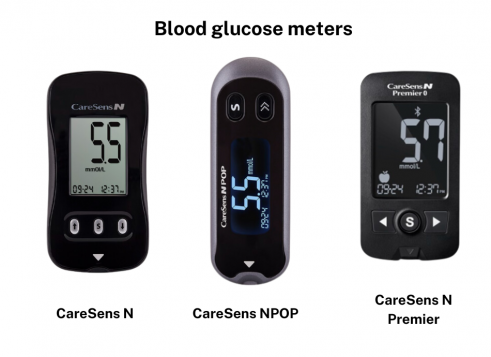Wishing everyone a safe and happy Christmas and New Year – Meri Kirihimete from the Healthify team.
Blood glucose test meters
Key points about blood glucose test meters
- A blood glucose meter helps you to check what your blood glucose levels are.
- A finger prick test is needed to use the meter.
- It's mainly used by people with type 2 diabetes who are on insulin, glipizide, gliclazide or glibenclamide.
- Learn more about blood glucose test meters.

A blood glucose test meter is a device used to test your blood glucose levels at home. You'll need to do a finger-prick test to use the meter.
How do I use it?
- Once you've pricked your fingertip with a lancet (finger pricker), a small drop of blood is placed on a disposable test strip.
- The meter reads this and displays your blood glucose level at the time you take the test..
- Learn more about diabetes – home blood glucose testing for type 2 diabetes.
To use the meter, you will also need:
- lancets (prickers)
- a lancing device
- blood glucose test strips.
It's also important to have a notebook, diary or app to record your blood glucose levels.
Note: For people who need to test for ketones and blood glucose, see dual blood glucose and blood ketone test meters.
Blood glucose test meters are funded for people who meet specific criteria – if you have:
- type 2 diabetes and are on insulin, glipizide, gliclazide or glibenclamide
- diabetes and are pregnant.
These criteria can change, so check with your diabetes nurse or doctor. If you don’t qualify for a subsidised blood glucose meter, you can expect to pay $50 to $70 to get fully set up with testing equipment.
In Aotearoa New Zealand the funded blood glucose test meters are:
- CareSens N
- CareSens N POP
- CareSens N Premier.

If you're not sure how to use your blood glucose meter, your healthcare provider can teach you. This could be a diabetes nurse educator or diabetes nurse specialist, your local pharmacist or a nurse at your GP surgery. Some cities have a representative from the company supplying your meter and they will be able to teach you if they are available.
Here is some guidance
- Gently push a test strip, with its contact bars facing up, into the test strip port at the bottom of the meter. This will turn the meter on.
- Prick your finger and touch the dot of blood with the narrow edge of the strip. Blood will be drawn up into the test strip.
- Wait for the meter to count down and then it will display the result.
Tips when using your test meter
- Make sure your hands are clean: Wash and dry your hands and fingertips before testing. If you have been handling something sweet before testing this may get into your test strip or meter and and make your reading falsely high.
- Pricking your finger: Prick your finger on the side (towards the tip) rather than on the pad (or tip). This will be more comfortable for you afterwards, especially if you use a keyboard. You'll get a much better sized drop of blood if your hands are warm before testing.
- The lancets (prickers) that are used within the finger-pricking device should be changed at least every 2 or 3 days. This reduces pain and also reduces the risk of infection.
Disposing of your diabetes supplies
You can dispose of test strips in the general rubbish. Lancets (finger prickers) must be disposed of in a sharps bin. Read more about the safe disposal of syringes, needles and other sharps.
Travelling
Here are some links to information you might find helpful if you have diabetes and need to travel.
- Diabetes and travelling(external link) Diabetes New Zealand
- Navigating airport security screening – guidance for people living with diabetes(external link) Aviation Security Service, NZ
- Travelling with children who have diabetes(external link) KidsHealth NZ
- Travel(external link) Diabetes Australia
- Travel and type 1 diabetes(external link) Diabetes Australia
Blood glucose monitoring(external link) Starship, NZ
References
- Diagnostic and monitoring devices for diabetes mellitus(external link) New Zealand Formulary
Credits: Sandra Ponen, Pharmacist, Healthify He Puna Waiora. Healthify is brought to you by Health Navigator Charitable Trust.
Reviewed by: Claire Salter, Clinical Pharmacist, Tauranga; Angela Lambie, Pharmacist, Auckland
Last reviewed:





